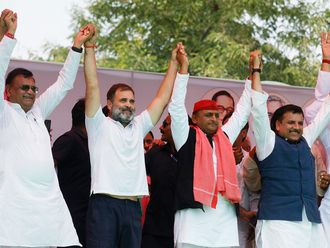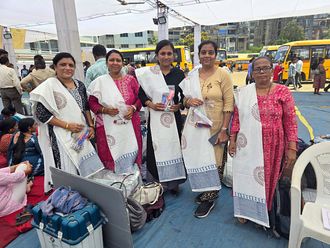
Do the manifestos of contending political parties matter? The question has suddenly become pertinent because of the ongoing battle of manifestos between the Bharatiya Janata Party (BJP) and the Congress. Both manifestos are based on competing guarantees and are full of populist promises.
There is, thankfully, a lighter side to Indian elections. Even in the midst of the heat and dust of intense, often bitter, sloganeering and campaigning, both the candidates and the voters find occasion to chuckle or laugh out loud.
As India’s general elections enter their second phase of voting on April 26, it is the clash of manifestos that provided some room for humour, whether intended or unintended.
Thus runs one of these dinner table conversations in the very thick of mutual recriminations.
“Hey, do you know who wrote the Congress manifesto?”
“I should imagine the party high command and their advisers?”
“No! The most important inputs came from overseas.”
“You gotta be kidding me! Why do you say that?”
“Well, whom does the Congress manifesto really benefit?”
“You mean their purported idea of wealth redistribution? Isn’t that classic socialism in a contemporary guise?”
“You got that wrong too.”
“It’s not supposed to benefit the have-nots?”
“It may never come to that. Before any redistribution happens, all the rich people will move to Dubai and Singapore … or to Mauritius, or farther offshore!”
“Good point. We Indians will never give up our wealth so easily. We’d rather stash it somewhere else.”
“Especially before people start snatching gold chains and necklaces to give to the chainless and the necklace-less masses!”
“Hahahaha!”
Real beneficiaries
The real beneficiaries of the Congress manifesto, so runs the above argument, would thus be friendly overseas states, rather than the Indian masses. That is where Indian wealth will flock before the government can get its hands on it.
This brings us to a more serious side of manifestos.
The Indian elections, with their vibrant democratic processes, showcase the vast and diverse sociopolitical canvas of the country. The heart of any election is arguably the promises and commitments made to the electorate, which in India, are embodied in the manifestos of various political parties.
In analysing the ongoing Indian elections, we need to consider how these manifestos reflect not only the ideological orientations and governance philosophies of their respective parties but also how they address the pressing needs, aspirations, and concerns of India’s billion-plus population.
The content of rival manifestos offers voters a glimpse into the future that each party envisions. From economic reforms to social welfare schemes, each document caters to specific demographics and socioeconomic groups.
One might find a pro-business narrative promising economic liberalisation and incentives for start-ups from one party, while another might focus on agrarian subsidies, employment guarantee schemes, and educational reforms, reflecting more socialist leanings.
The battle is not merely between different visions for India’s development but also about credibility and the ability to deliver on promises. Voters, now more than ever, scrutinise past performances and seek actionable plans rather than lofty ideals.
In urban areas, there may be a focus on infrastructure development, digitalisation, and urban governance. In contrast, rural manifestos might prioritise agricultural policies, water conservation, and village empowerment. Gender-specific pledges, including women’s safety and empowerment programs, are increasingly gaining prominence, echoing the shifting societal concerns.
Moreover, within these manifestos lie the not-so-subtle appeals to identity politics, especially along religious, ethnic, caste, community, linguistic, and regional lines. Some of these clearly fly in the face of the model code of conduct. No wonder the Election Commission has pulled up both the ruling BJP and the Congress, without naming their respective “star campaigners,” for violations.
Not just promises, but mutual abuse is also par for the course, all strategically leveraged to galvanise support from various communities and religious groups. It’s a complex power play, often weaponising and capitalising on regional sentiments, historical injustices, and cultural pride.
Mere policy proposals
Another critical aspect of this battle is the engagement and mobilisation strategy that accompanies these documents. How parties communicate their agendas — via rallies, door-to-door campaigns, or through alliances with civil society — can significantly influence their effectiveness.
The modern Indian electorate is savvy, with access to vast amounts of information and a growing awareness of their electoral power. Thus, the effort to win hearts and minds goes well beyond the printed page. Social media plays a huge role.
In India’s electoral context, manifestos often transcend mere policy proposals and symbolise the ethos of the political parties. They are meant to form a social contract between the party and the citizens, with the implicit understanding that the fulfilment of these promises will shape the trust and credibility that parties wish to build or sustain.
A deeper analysis of these manifestos requires a critical lens that also factually examines the feasibility and financial implications of the promises made. Populist measures are the staple of electoral politics; however, they must be weighed against the structural reforms necessary for sustained growth and development.
But, to revert to the dinner table conversation over competing manifestos, the truth is that manifestos don’t matter as much as they are supposed to. The Indian electorate knows only too well that the promises that politicians make to stay in or return to power are, more often than not, honoured in their breach.
As far as the ruling BJP is concerned, it is the Modi magnet, not the Modi manifesto, that makes the difference.











